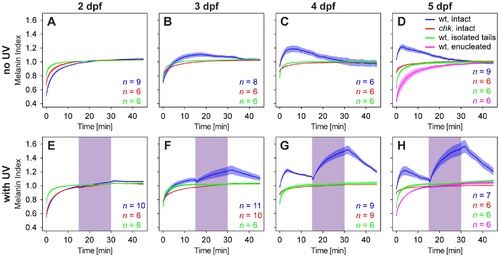Fig. 2
- ID
- ZDB-FIG-141217-17
- Publication
- Mueller et al., 2014 - Sunscreen for fish: co-option of UV light protection for camouflage
- Other Figures
- All Figure Page
- Back to All Figure Page
|
Influence of ocular photoreceptors on pigmentation of larval zebrafish. Similar to the situation found in wildtype embryos at 2chk mutant larvae, of blinded wildtype larvae as well as of isolated tails disperse upon stimulation with visible light (A-D) and show no additional reaction to UV light (E-H). In contrast, visible light induces a delayed aggregation of melanosomes in wildtype intact larvae of 3 dpf and older (B-D) while exposure of these larvae to UV light leads to a pronounced dispersion of melanosomes (F-H). Values represent means ±1 SEM and are relative to the extent of pigmentation after 30 minutes light adaptation, i.e. a melanin index >1 means the larva is darker compared to the appearance after light adaptation, and vice versa, a value <1 means the larva appears paler compared to the appearance after light adaptation. For ease of comparison, all graphs are drawn at the same scale. Purple shaded areas mark the time interval when the UV light was on. |
| Fish: | |
|---|---|
| Condition: | |
| Observed In: | |
| Stage Range: | Protruding-mouth to Day 5 |

